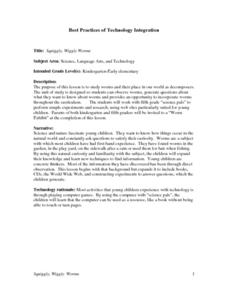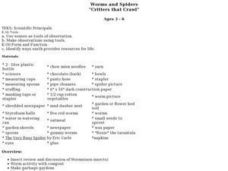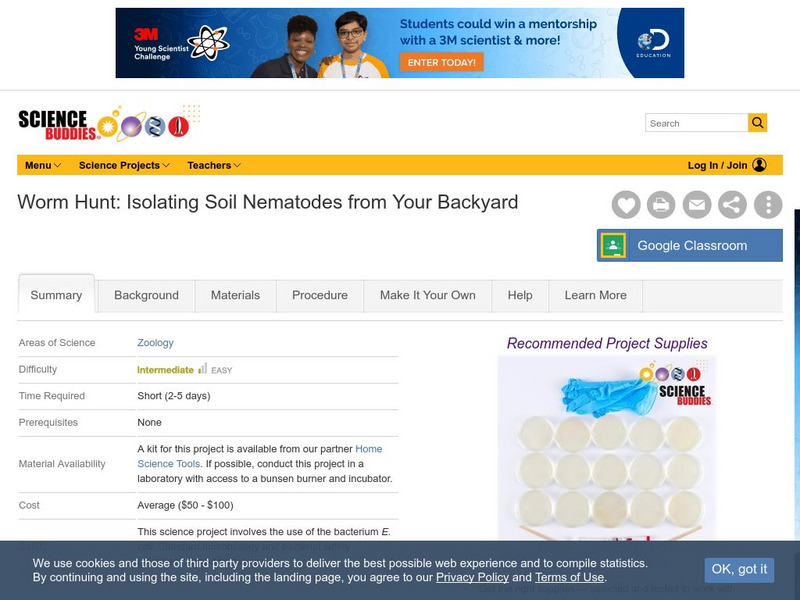Curated OER
Things We Can Learn From a Cow and a Worm
In this conservation instructional activity, students answer 5 questions about how cows and worms recycle and conserve natural resources. Students then fill in a Venn diagram outlining ways they can recycle and conserve.
Curated OER
Making a Mini Worm Habitat
Students explore the process of converting organic waste into usable fertilizer. They observe how living and nonliving things interact with one another by making a mini-worm habitat.
Curated OER
Squiggly, Wiggly Worms
Students, who are in early elementary grades, pair with fifth grade students to study worms. They observe worms in experiments, create research questions, and complete the research using Internet sites. They participate in a "Worm...
Curated OER
Causal Patterns in Ecosystems Section 3
Students design and create a worm and worm free compost tanks for observation of decay in ecosystems. They make predictions, care, and revist tanks using their journals for observation and data collection.
Curated OER
Worm Watching
Students examine the role earthworms play in building soils. They discuss worms and what they do with soil, make predictions and draw pictures, and observe their worms in soil over a two week period.
Curated OER
Animals: Worms
Students research the physical characteristics of mealworms and tubefex. In this worm lesson, students explore worms using a microscope. Students search their environment for worms.
Curated OER
Working Worms
Fourth graders examine earthworms. For this earthworm lesson, 4th graders investigate how earthworms help prepare soil for planting. Students examine other living and nonliving elements in a garden habitat.
Curated OER
Facts or Opinions - Wonderful Worms
Students watch a video about how the worm's value affects the environment and create a fact and opinion chart about it. In this fact and opinion lesson plan, students create a 2 column chart analyzing what is fact and what is opinion...
Curated OER
Convening, Creating, and Conventioneering
Students study coelenterates. In this science lesson, students author a story regarding the life cycle of coelenterates following an in depth study of the creatures.
Curated OER
Mini Beast Safari Record Sheet
In this bugs and insects in their habitats worksheet, students hunt and locate worms, bugs, and other insects then record their findings to complete the chart.
Curated OER
Don't Worm Your Way Out of This One!
Students study different aspects of worms along with the process of vermicomposting by participating in a class experiment to study the time it takes for breakfast cereal to be eaten by worms.
Curated OER
Big Fat, Juicy Worms
Students collect and study information about worms. They discover how an earthworm helps process and loosen the soil. They write in their journals as well.
Curated OER
Worms and Spiders: "Critters That Crawl"
Students complete a unit of lessons on spiders and worms. They discuss worm and spider characteristics, create a garbage garden, observe worms, create gummy worm prints, read the book, 'The Very Busy Spider,' and construct a spider and...
Curated OER
More Bait for Your Buck!
Students determine where to buy the heaviest earthworms as they study invertebrates. They create a double bar graph of the results of the weight data.
Curated OER
LIfe Underground
Students investigate the ecological relationship of worms and plants. They discuss the experiment of observing worms in a jar with plants. Then record the data every few days. The students write an imaginary story about their...
Curated OER
Genes and Aging
Students explore genes and the way we age. They assemble a worm collection device called a Baermann Funnel. Students collect Caenorhabditis elegans or other active nematodes from local soil samples. They observe the appearance and...
Curated OER
The Effects of Ultraviolet Light on Lumbriculus
Students explore the effects of ultraviolet light on Lumbriculus. They expose ultraviolet light to Lumbriculus (worm) and determine the lethal exposure time. They examine the worm and record their observations.
Curated OER
What type of soil do worms like?- An Investigation
Students study four types of soil and predict which one worms would use for their habitat. They observe worms in each type of soil and monitor their activity. They create class charts highlighting their discoveries.
Curated OER
A Worm World
Pupils maintain a compost bin and build a worm observatory. They design experiments relating to worms and record observations in a worm journal.
Science Buddies
Science Buddies: How Much Worm Is a Worm?
Worms are slimy, wiggly, and gross. But did you know that they have many unique abilities? One of the neatest things that worms can do is regenerate, or re-grow, parts of their body. After a piece of a worm is cut off, it can grow back...
Science Buddies
Science Buddies: Worm Hunt: Isolating Soil Nematodes From Your Backyard
Nematodes, also called roundworms, are the most abundant animal on Earth and can be found in your back yard, playgrounds, and many other places. This lab involves isolating nematodes from several soil samples to discover the best...
Estrella Mountain Community College
Estrella Mountain Community College: Phylum Annelida
This section (in table of contents as "Phylum Annelida: Segmented Worms") gives a description of how segmented worms developed certain characteristics as well as it explains the differences in the evolution of different classes of...
BioEd Online
Bio Ed Online: Living Things and Their Needs: Animals' Needs
Students learn about the basic needs of animals by creating and observing a worm terrarium. The instructional activity and student worksheets can be downloaded in PDF format.

























